Pembleton mkII - Tin Tub
Discussion
Introduction
Having owned my 2cv engined Pembleton for now just over a year, I’ve never quite been happy with it. In my ownership so far I’ve done quite a few bits and bobs to it that can be read on my other thread HERE
My main issue is its size. It’s very small and I’m not… 6ft 4” and 110kgs to be precise. I’ve helped the situation by fitting a smaller diameter dished wheel and a moulded seat base, but it’s still not exactly spacious. When it’s 2 up, both me and the passenger are wedged in at the hips. When I bought it I convinced myself it was okay, and despite it not being completely un-driveable, it still isn’t where I want it to be.
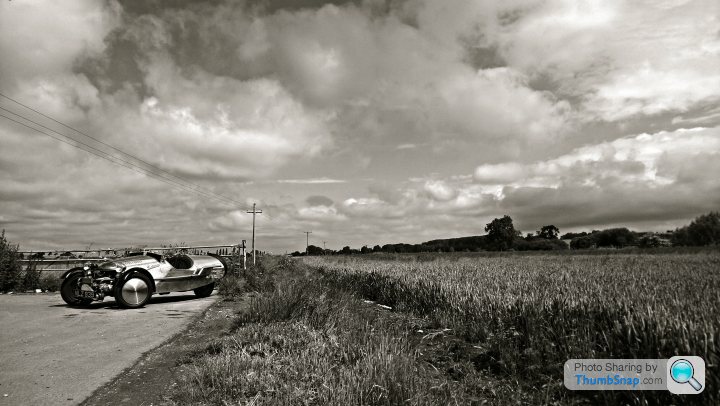
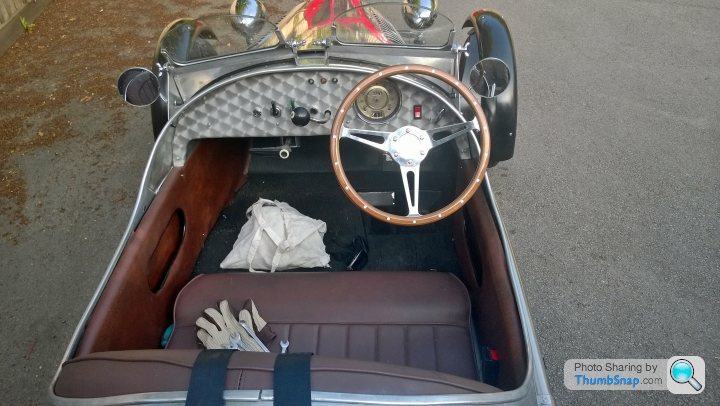
In my quest for a suitable replacement I nearly bought a Westfield SEW. This was very fast and hugely fun, but it just didn’t feel special enough. At the risk of sounding bah humbug and derogatory, it just felt like a plastic kit car, albeit a very fast, capable one.
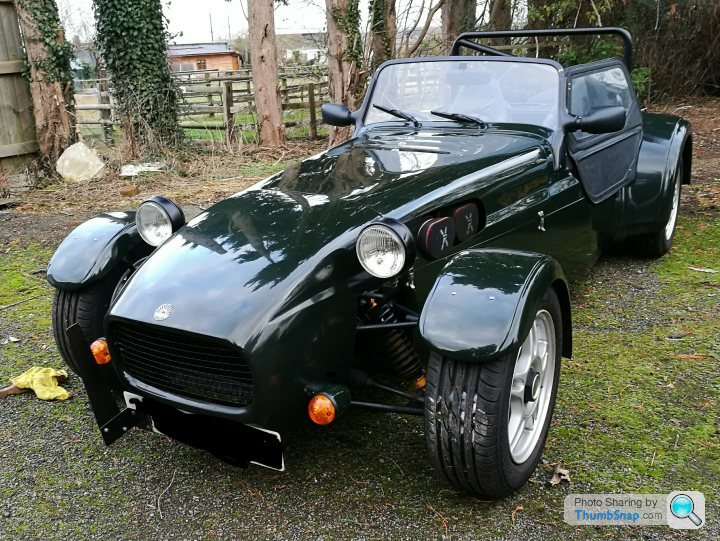
I also went to Mark Grinnalls workshop and sat in a selection of Scorpions he had in. Alas, I’m too tall/wide again so it was back to the drawing board.

One option was to chop the Pembleton in half and make it longer, this would certainly fix the length problem, but would still be an issue at the hips, and I didn’t like the idea of taking what is otherwise a beautifully finished vehicle and butchering it.
In a bit of a flippant comment to my wife about building myself a car, she looked at me blankly and said “well, why don’t you? I think it’s a good idea as then you’ll get exactly what you want”… this started my brain on a mission.
Phil and Guy, who own and run the Pembleton motor company, offer a LWB chassis. Upon speaking to Phil, it became apparent that this chassis may be perfect for my needs. It has an additional 8” of length, and 3” of width in the cockpit (as the actress said to the bishop) and he has used this chassis to build a factory assembled car for a 6ft 6” BIG BLOKE, and he was absolutely fine. So the hunt was on for parts/donor.
Having owned my 2cv engined Pembleton for now just over a year, I’ve never quite been happy with it. In my ownership so far I’ve done quite a few bits and bobs to it that can be read on my other thread HERE
My main issue is its size. It’s very small and I’m not… 6ft 4” and 110kgs to be precise. I’ve helped the situation by fitting a smaller diameter dished wheel and a moulded seat base, but it’s still not exactly spacious. When it’s 2 up, both me and the passenger are wedged in at the hips. When I bought it I convinced myself it was okay, and despite it not being completely un-driveable, it still isn’t where I want it to be.


In my quest for a suitable replacement I nearly bought a Westfield SEW. This was very fast and hugely fun, but it just didn’t feel special enough. At the risk of sounding bah humbug and derogatory, it just felt like a plastic kit car, albeit a very fast, capable one.

I also went to Mark Grinnalls workshop and sat in a selection of Scorpions he had in. Alas, I’m too tall/wide again so it was back to the drawing board.

One option was to chop the Pembleton in half and make it longer, this would certainly fix the length problem, but would still be an issue at the hips, and I didn’t like the idea of taking what is otherwise a beautifully finished vehicle and butchering it.
In a bit of a flippant comment to my wife about building myself a car, she looked at me blankly and said “well, why don’t you? I think it’s a good idea as then you’ll get exactly what you want”… this started my brain on a mission.
Phil and Guy, who own and run the Pembleton motor company, offer a LWB chassis. Upon speaking to Phil, it became apparent that this chassis may be perfect for my needs. It has an additional 8” of length, and 3” of width in the cockpit (as the actress said to the bishop) and he has used this chassis to build a factory assembled car for a 6ft 6” BIG BLOKE, and he was absolutely fine. So the hunt was on for parts/donor.
Edited by Ambleton on Monday 10th October 21:53
Thanks!
I have a deeply unsettling love for stupid cars, especially three wheelers. They're just so unusual I can't help but be drawn in by them!
Be warned this will be a long running thread! But I will keep it up to try to be thorough. I'm sure a lot of people will get bored, but I want this to almost be a full build blog.
I will be running the 2 Pembleton threads in parallel for a while. The plan is to keep the current one (making it better all the time) until my second one is completed, then sell my current one...
I have a deeply unsettling love for stupid cars, especially three wheelers. They're just so unusual I can't help but be drawn in by them!
Be warned this will be a long running thread! But I will keep it up to try to be thorough. I'm sure a lot of people will get bored, but I want this to almost be a full build blog.
I will be running the 2 Pembleton threads in parallel for a while. The plan is to keep the current one (making it better all the time) until my second one is completed, then sell my current one...
Edited by Ambleton on Thursday 20th April 21:13
Jonmx said:
One of my ex's fathers had a Lomax 3 wheeler, I thought it was bloody stupid, then I had a go in it. I still thought it was bloody stupid, but great fun! I can see why people take a shine to them. 
It all started with a Lomax over 8 years ago at the ripe old age of 18! 
www.pistonheads.com/gassing/topic.asp?t=871767
Not many people get the chance to build themselves a car at 26!
Engine
People have used all sorts of engines over the years. Engines that have been mated to 2cv gearboxes include the BMW airhead engines from the R75, R80 and R100 bikes, the later BMW oil head engines from the likes of the R850 and R1100 (like the kits Pete Sparrow sells), the flat 4 engine from the Ami Super/GS and Moto Guzzi engines of all types and sizes, I’ve even seen one with a Panhard flat twin.
In my opinion nothing beats the look of a Vtwin at the front of a cycle car, like the early morgans...
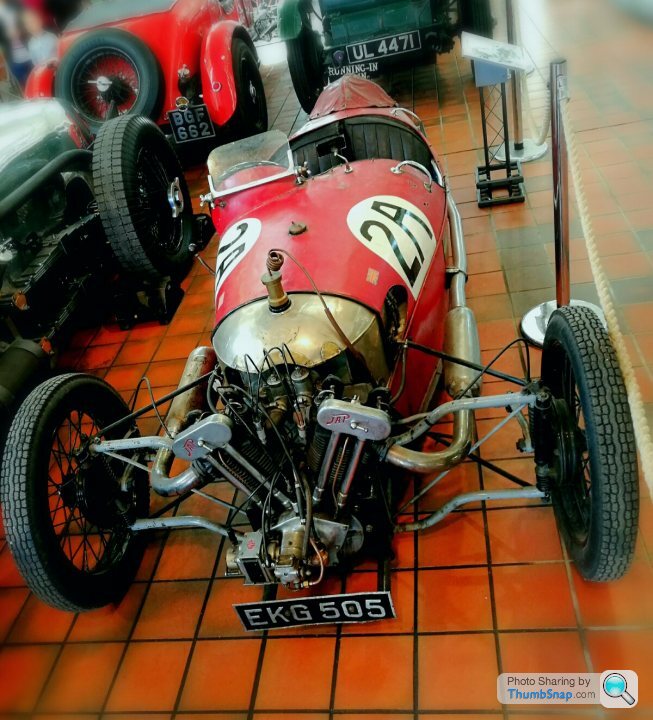
The Moto Guzzi 750cc small block is supposed to be the best engine for a Pembleton. Its output of 48bhp is a healthy 70% increase over the standard 29bhp from the 2cv motor, and it revs a bit higher too.
Fitted with Phil Gregorys (Pembleton Motor Company) 19" wire wheels increases the top speed a bit, and if you want an even higher cruising speed, then you can fit a 2cv/Dyane hybrid gearbox, which offers a 4% increase in top. this is made up of the 2cv gearset, with the crownwheel and pinion from the dyane.
This engine is almost exactly the same weight as a 2cv engine, so it doesn’t upset the balance of the vehicle either.
The earlier carb bikes are the best. The later ones are fuel injected and I didn’t want the hassle of fitting all the sensors and switches to trick the ecu into thinking that things like the centre stand were folded away, adding in a lambda sensor and all the extra wiring.
It’s a relatively simple job to mate a Guzzi small block to a 2cv gearbox as its just 3x adaptor plates and a bit of jiggery pokery. Other, bigger, guzzi engines can be used but the extra grunt and weight can unsettle it, and it’s a more complicated job, with the engine hanging out further at the front too. I also didn’t like the idea of lunching the gearbox, which has remained largely unchanged since the first 425cc 2cv with 12bhp.
I was given a tip off about a 1991 Moto Guzzi 750T that was being broken as the final drive had seized. The 750T was a UK market specific bike that never sold very well. Stock image below...

A call to the seller and an exchange of emails had secured almost everything I needed, including a full electronic ignition, dynamo and rectifier, coils etc. I now need to source a pair of Carbs, but these can be bought new from Dellorto at a reasonable cost (circa £200)
Images of the engine below....
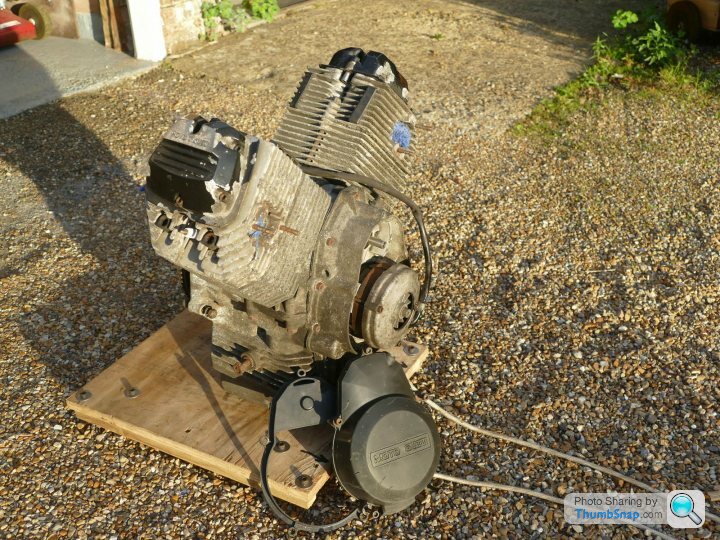
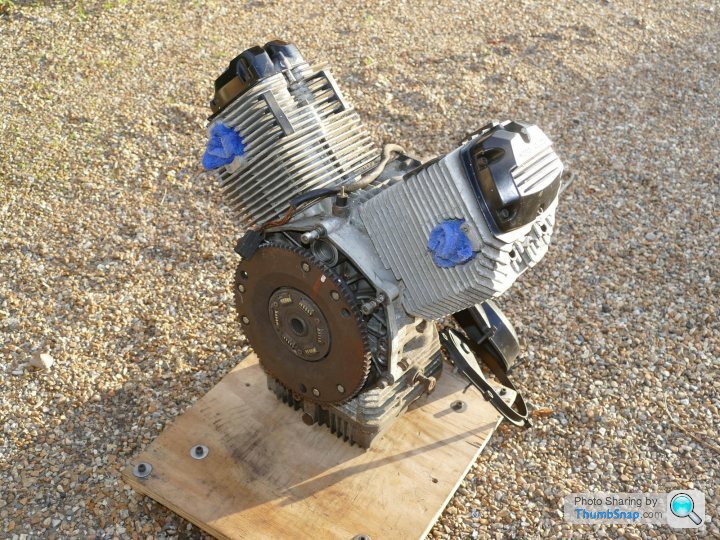
It'll need a freshen up, but that will come later!
People have used all sorts of engines over the years. Engines that have been mated to 2cv gearboxes include the BMW airhead engines from the R75, R80 and R100 bikes, the later BMW oil head engines from the likes of the R850 and R1100 (like the kits Pete Sparrow sells), the flat 4 engine from the Ami Super/GS and Moto Guzzi engines of all types and sizes, I’ve even seen one with a Panhard flat twin.
In my opinion nothing beats the look of a Vtwin at the front of a cycle car, like the early morgans...

The Moto Guzzi 750cc small block is supposed to be the best engine for a Pembleton. Its output of 48bhp is a healthy 70% increase over the standard 29bhp from the 2cv motor, and it revs a bit higher too.
Fitted with Phil Gregorys (Pembleton Motor Company) 19" wire wheels increases the top speed a bit, and if you want an even higher cruising speed, then you can fit a 2cv/Dyane hybrid gearbox, which offers a 4% increase in top. this is made up of the 2cv gearset, with the crownwheel and pinion from the dyane.
This engine is almost exactly the same weight as a 2cv engine, so it doesn’t upset the balance of the vehicle either.
The earlier carb bikes are the best. The later ones are fuel injected and I didn’t want the hassle of fitting all the sensors and switches to trick the ecu into thinking that things like the centre stand were folded away, adding in a lambda sensor and all the extra wiring.
It’s a relatively simple job to mate a Guzzi small block to a 2cv gearbox as its just 3x adaptor plates and a bit of jiggery pokery. Other, bigger, guzzi engines can be used but the extra grunt and weight can unsettle it, and it’s a more complicated job, with the engine hanging out further at the front too. I also didn’t like the idea of lunching the gearbox, which has remained largely unchanged since the first 425cc 2cv with 12bhp.
I was given a tip off about a 1991 Moto Guzzi 750T that was being broken as the final drive had seized. The 750T was a UK market specific bike that never sold very well. Stock image below...

A call to the seller and an exchange of emails had secured almost everything I needed, including a full electronic ignition, dynamo and rectifier, coils etc. I now need to source a pair of Carbs, but these can be bought new from Dellorto at a reasonable cost (circa £200)
Images of the engine below....


It'll need a freshen up, but that will come later!
Other Donor Bits
With the engine now acquired, it was time to hunt for the rest of the bits I needed.
I managed to locate a chap who was selling an Ami rolling chassis. or those unfamiliar with old citroens, the ami was basically a larger car available as a saloon or estate based on 2cv underpinnings...
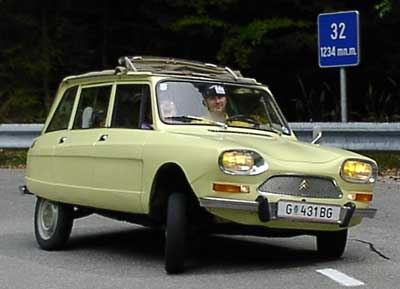
It had been stood on a farm for many years and was cheap, I have its number plates and all the numbers are matching, so I'll apply for the V5
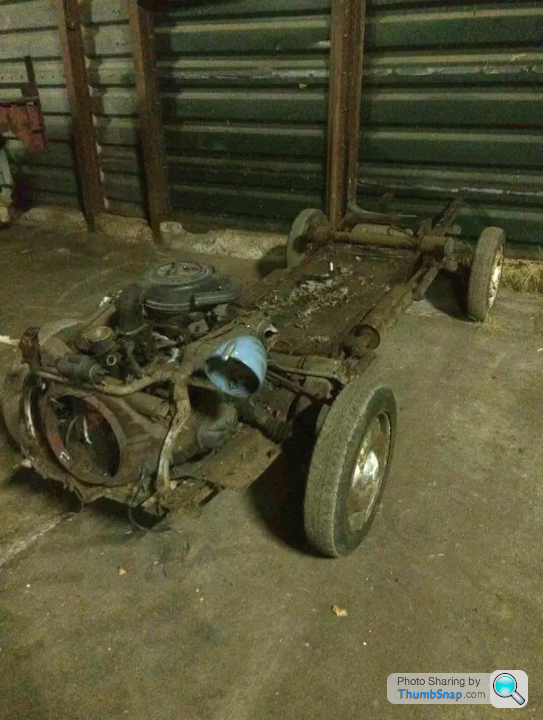
A deal was done and I went to collect it in a partially stripped down state with a hire van. There are several advantages to an Ami, and some challenges.
First off, they have inertia dampers mounted to the hubs. These are quite heavy, but once removed, will give free mounting holes for rotating mudguards – something that is missing on my current Pembleton. In addition to this they have larger, stronger wheel bearings, a Citroen M28 engine (+3bhp and higher compression of 9.0:1), an ARB (not fitted to 2CVs or dyanes), and a slightly different steering rack where the pinion comes out at a steeper angle. I have a spare 2cv steering rack floating around so I might use this instead… I’ll cross that bridge when I get to it…
Conversely the rear arm offset is slightly shorter as the track at the rear slightly narrower on an Ami. In my instance (using just one of the rear arms, turned around) I’ll either need to mod the chassis to get the rear wheel to sit centrally, or locate a suitable 2CV rear arm and use that instead.
Another option is to put an MGA wire wheel on the back with a splined adaptor. This will change the offset of the fitting, but I want to ensure that these 2 figures are the same before I commit to anything as I really don’t want an offset rear wheel….
In addition to this, as Amis are now very thin on the ground, so unwanted spares/parts are much more desirable.
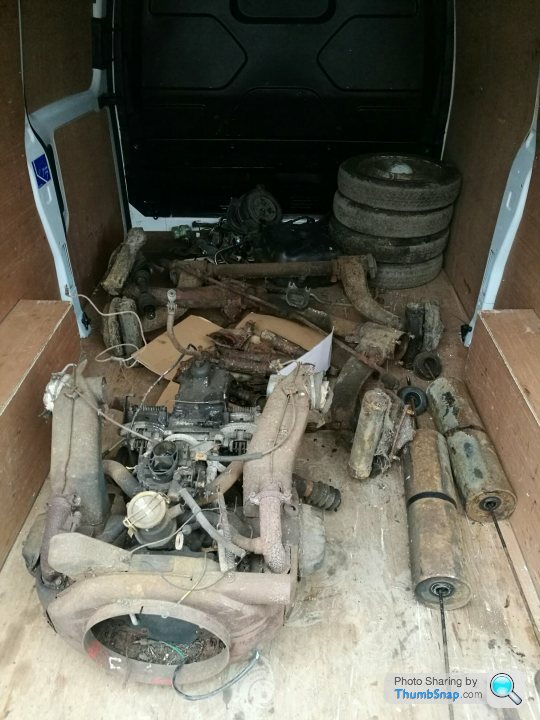
Everything is very mucky, oily and greasy, but generally sound....
With the engine now acquired, it was time to hunt for the rest of the bits I needed.
I managed to locate a chap who was selling an Ami rolling chassis. or those unfamiliar with old citroens, the ami was basically a larger car available as a saloon or estate based on 2cv underpinnings...

It had been stood on a farm for many years and was cheap, I have its number plates and all the numbers are matching, so I'll apply for the V5

A deal was done and I went to collect it in a partially stripped down state with a hire van. There are several advantages to an Ami, and some challenges.
First off, they have inertia dampers mounted to the hubs. These are quite heavy, but once removed, will give free mounting holes for rotating mudguards – something that is missing on my current Pembleton. In addition to this they have larger, stronger wheel bearings, a Citroen M28 engine (+3bhp and higher compression of 9.0:1), an ARB (not fitted to 2CVs or dyanes), and a slightly different steering rack where the pinion comes out at a steeper angle. I have a spare 2cv steering rack floating around so I might use this instead… I’ll cross that bridge when I get to it…
Conversely the rear arm offset is slightly shorter as the track at the rear slightly narrower on an Ami. In my instance (using just one of the rear arms, turned around) I’ll either need to mod the chassis to get the rear wheel to sit centrally, or locate a suitable 2CV rear arm and use that instead.
Another option is to put an MGA wire wheel on the back with a splined adaptor. This will change the offset of the fitting, but I want to ensure that these 2 figures are the same before I commit to anything as I really don’t want an offset rear wheel….
In addition to this, as Amis are now very thin on the ground, so unwanted spares/parts are much more desirable.

Everything is very mucky, oily and greasy, but generally sound....
Ambleton said:
Conversely the rear arm offset is slightly shorter as the track at the rear slightly narrower on an Ami. In my instance (using just one of the rear arms, turned around) I’ll either need to mod the chassis to get the rear wheel to sit centrally, or locate a suitable 2CV rear arm and use that instead.
Or the third option would be to modify the Ami rear arm.2cv arm would be easier, but you'd be losing the bigger wheel bearing (which is probably more relevant on the back than the front).
TooMany2cvs said:
Or the third option would be to modify the Ami rear arm.
2cv arm would be easier, but you'd be losing the bigger wheel bearing (which is probably more relevant on the back than the front).
That is also an option... I'm hoping that the offset change in an MGA wire wheel + adaptor = 1/2 the change in rear track between the 2cv and ami...2cv arm would be easier, but you'd be losing the bigger wheel bearing (which is probably more relevant on the back than the front).
That way I could have wire wheels all round and everything would match without any cutting/welding of chassis or suspension arms.
It would also mean a wider rear wheel, not that it changes anything much.
A bit of light googling has unearthed that the rear track of the 2cv is 1260mm, and the rear track if the ami is 1220mm...
I know they used the same cross tube and wheels, so each of the arms are 20mm narrower athwart...
I need to measure up the mga wheel and adaptor I have! Here's hoping
I know they used the same cross tube and wheels, so each of the arms are 20mm narrower athwart...
I need to measure up the mga wheel and adaptor I have! Here's hoping
If you like Morgan three-wheelers (and let's be honest, what's not to like!!), then the Club Opening Run is on tomorrow at Milton Keynes Museum.
There will be plenty of proper v-twins to gawp over there.
https://www.mtwc.co.uk/2017/01/are-you-ready-for-t...
There will be plenty of proper v-twins to gawp over there.
https://www.mtwc.co.uk/2017/01/are-you-ready-for-t...
So what have I got
The first thing to do was to start to break down the larger chunks of the donor. The Inertia dampers came off without too much trouble. One of the captive studs started rotating, but the nut was carefully cut free. Once given a tickle with a wire wheel they came up pretty and upon giving them a vigorous shake, appeared to be working well too. I managed to sell these for £100 and sent them packing off up to Scotland..
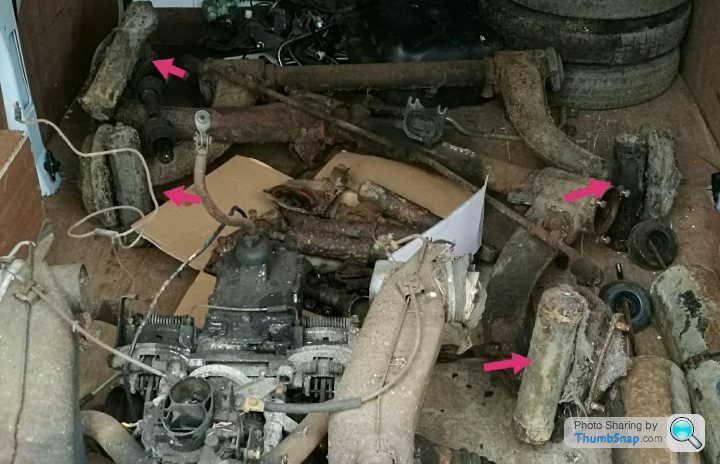
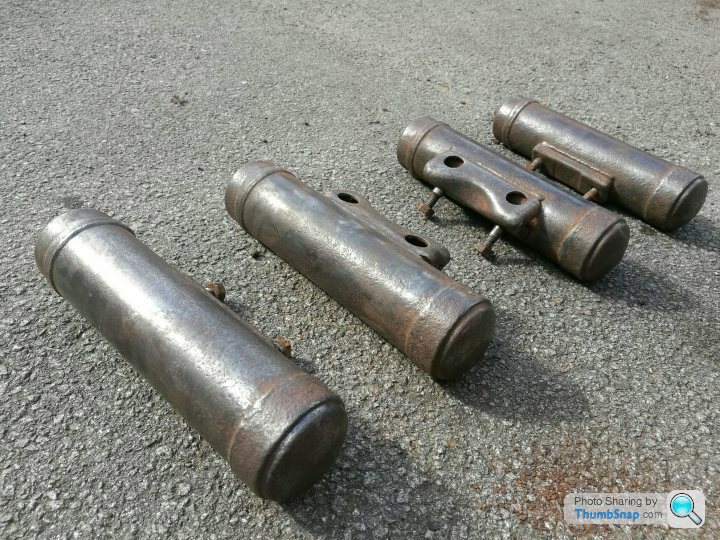
Whilst getting the engine/gearbox out the back of the van with my wife and shoving it in the back of the garage, it became apparent it was not manageable to keep them together. I underestimated how much stronger I was than my wife and subsequently she ended up hurting herself (not seriously). Although they’re relatively light components (for an engine and gearbox), the assembly was probably approaching 80kgs. After a couple of weeks in the back of the garage I decided it was time to drag it out and get it split.
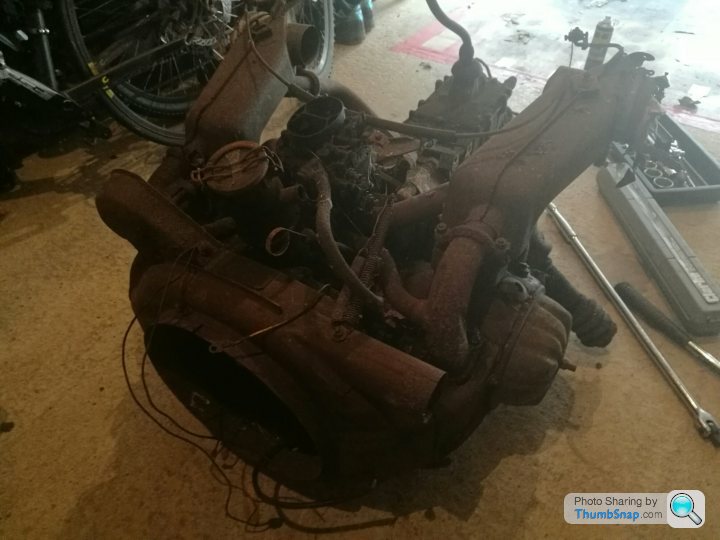
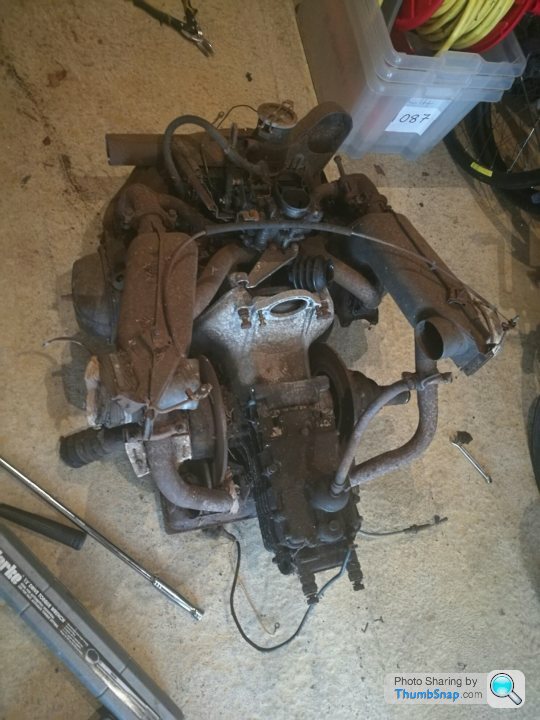
First and easiest parts to remove are the brake callipers from the gearbox casting. These come in 2 halves and are really simple, but effective little units with the handbrake mechanism and pads in the same assembly.
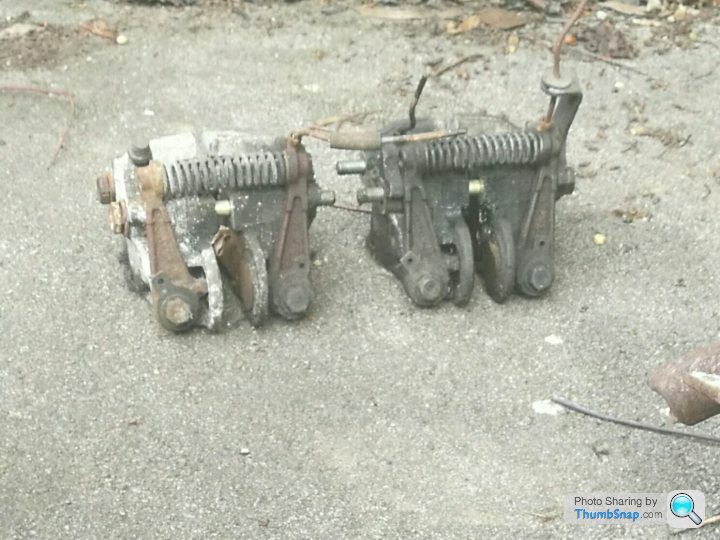
Next to be removed was the central solex carb, inlet/exhaust spider, heat exchanger shrouds and first silencer. The 4x bolts and 4x nuts that hold the spider were thankfully okay to remove (no shearing) and with some careful (read barbaric) use of the angle grinder on the rusted exhaust down pipes, came free without much hassle.
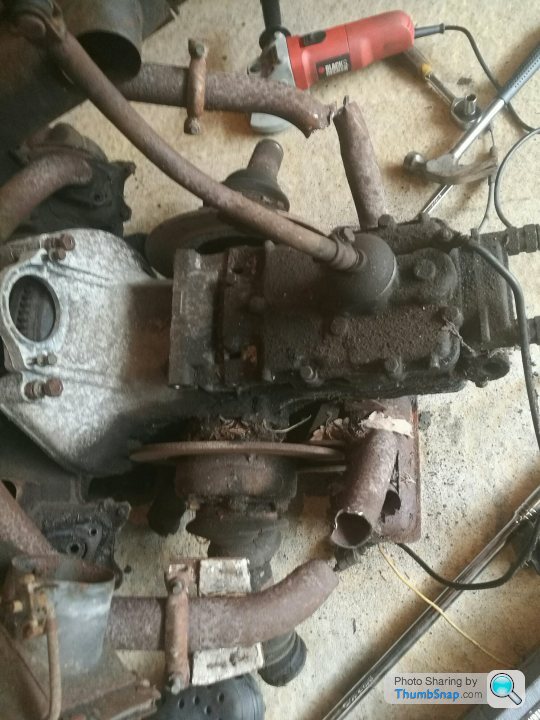

After a few more nuts removed the remnants of the exhaust system lifted away without issue
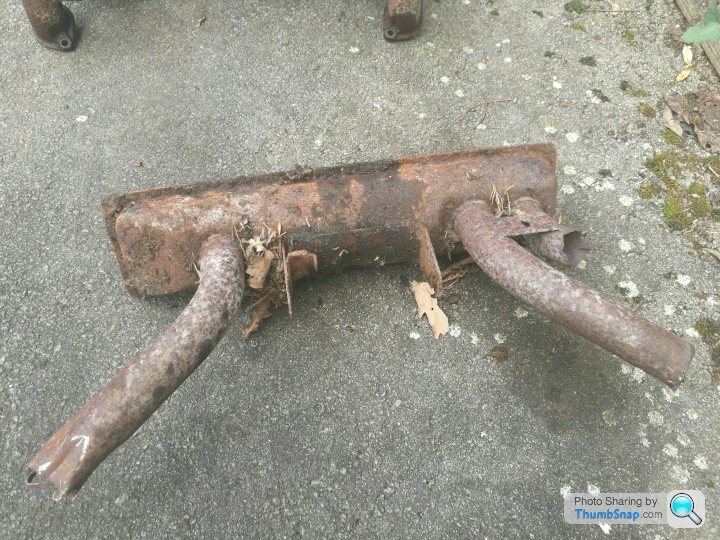
After this, I decided the next action was to remove the gearbox. This at least means that I now have 2 manageable chunks to move around at about 35-40kgs a piece, instead of one big lump. Only four studs hold the gearbox and engine together and they all came out trouble free. Thankfully, although everything is tight, nothing seems to be seized.
Gearbox separated.
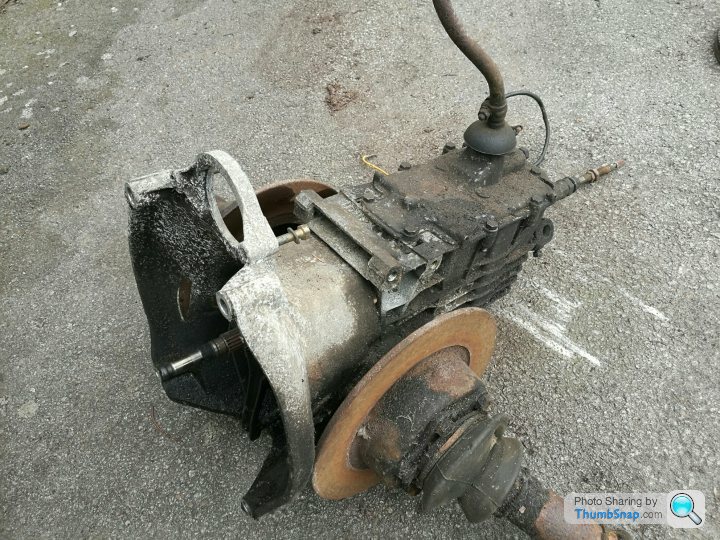
With the gearbox now out of the way we can see the clutch on the back of the flywheel.
This is an old clutch (possibly the original) and is a 3 finger design. Instead of a diaphragm clutch where it’s a pressed piece of spring steel offering many self-sprung fingers, this design had 3 plates with hinges and torsion springs. You cannot get these type of clutches anymore and instead I will need a diaphragm conversion. As you can see, despite all the rust, it’s actually not that bad.
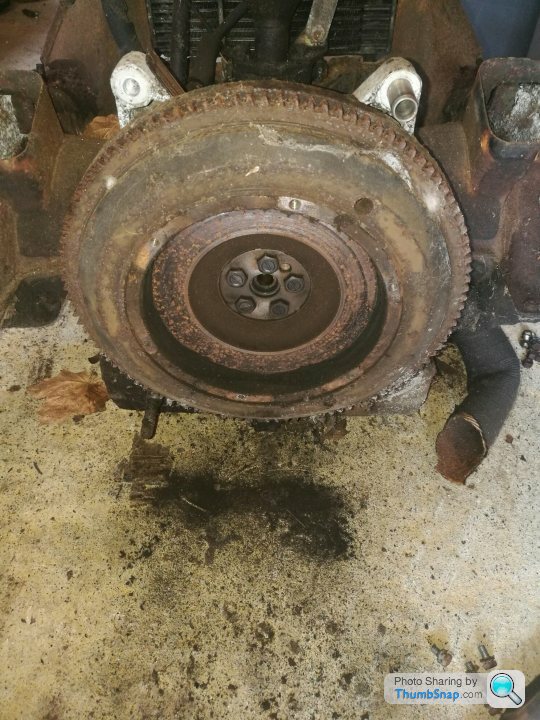
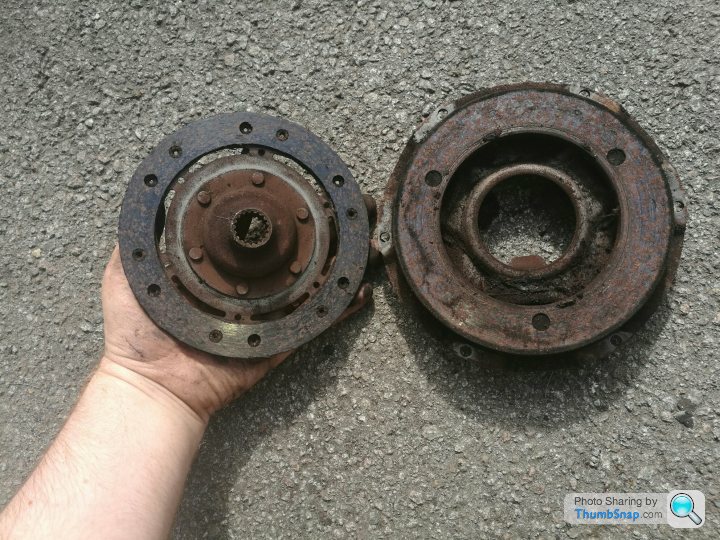
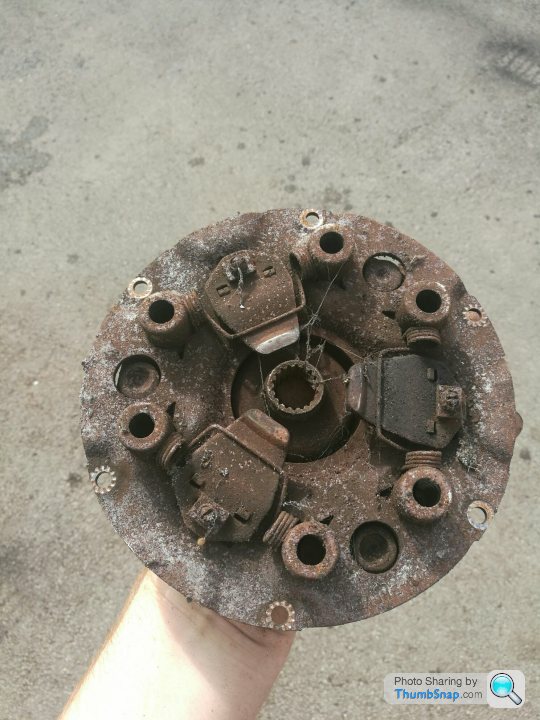
With the clutch off, it’s now time to remove the flywheel. This is a pretty lardy thing at about 9.5kgs, so removal assists lugging the engine around too. This is held on by 5 bolts. The plan is to get it lightened and balanced, so should improve engine response between gear changes and acceleration, which is a worthwhile trade off against tractability and rolling torque uphill, which is remedied by the more powerful engine. There’s not many people who do this now, so I’ll have to do my research and locate someone to do it.
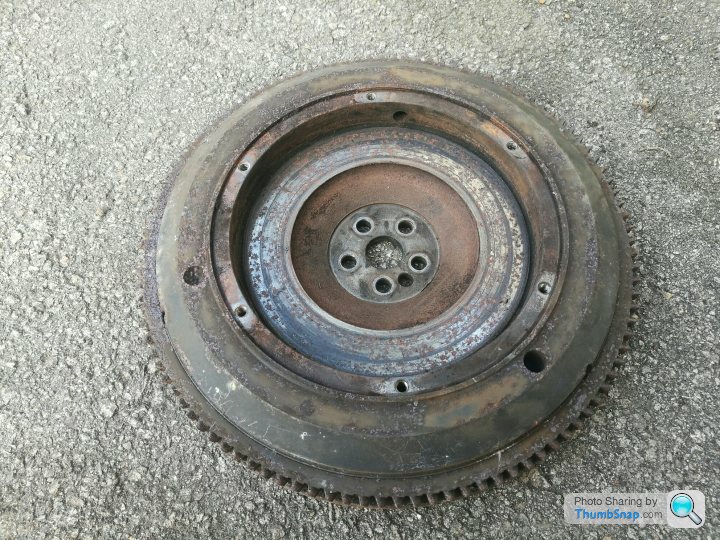
Now it’s time to tackle all the crusty, knackered cooling shrouds and tin-ware. This had rusted through in places and was not pretty. It’s very thin and so resembles a razor blade too. Most of the screws were seized into this or just broke through the rust – the rest were cut off with a grinder.
Now all this is removed we can actually see the bare bones of the engine. Upon trying to remove the oil cooler, one of the ali pipes had seized in the union and sheared the tube, so I cut the legs.
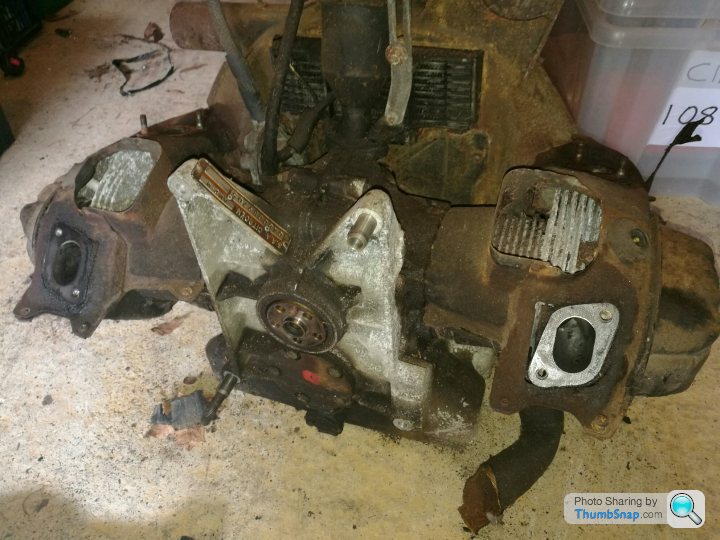
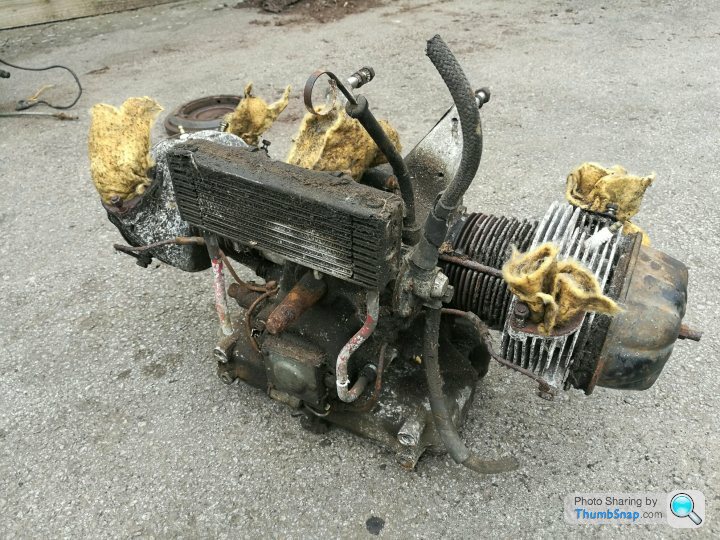
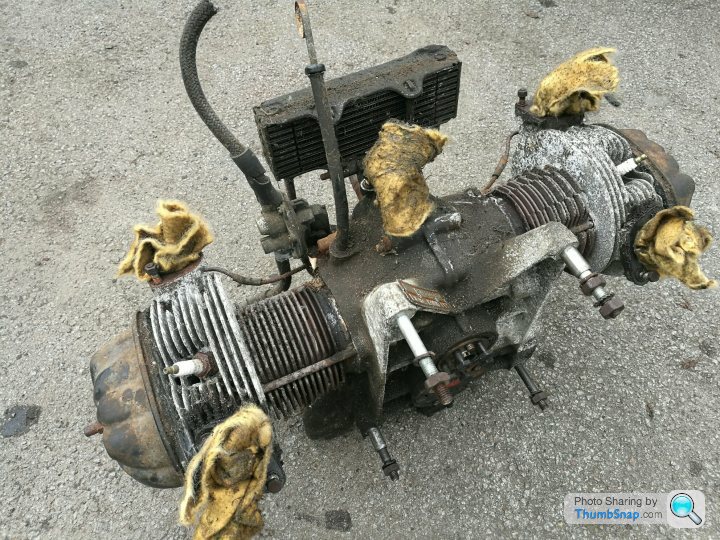
Thats a whole load of crappy tinware! If it was in half decent nick it would be worth a fair bit! Buts its not....
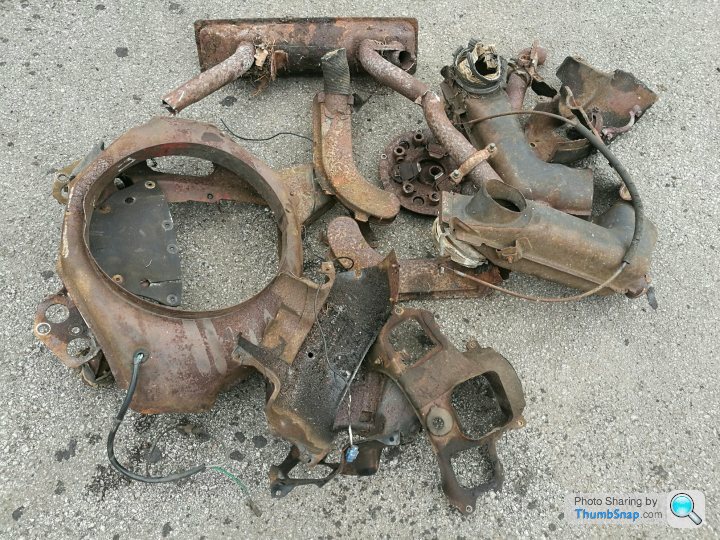
The first thing to do was to start to break down the larger chunks of the donor. The Inertia dampers came off without too much trouble. One of the captive studs started rotating, but the nut was carefully cut free. Once given a tickle with a wire wheel they came up pretty and upon giving them a vigorous shake, appeared to be working well too. I managed to sell these for £100 and sent them packing off up to Scotland..


Whilst getting the engine/gearbox out the back of the van with my wife and shoving it in the back of the garage, it became apparent it was not manageable to keep them together. I underestimated how much stronger I was than my wife and subsequently she ended up hurting herself (not seriously). Although they’re relatively light components (for an engine and gearbox), the assembly was probably approaching 80kgs. After a couple of weeks in the back of the garage I decided it was time to drag it out and get it split.


First and easiest parts to remove are the brake callipers from the gearbox casting. These come in 2 halves and are really simple, but effective little units with the handbrake mechanism and pads in the same assembly.

Next to be removed was the central solex carb, inlet/exhaust spider, heat exchanger shrouds and first silencer. The 4x bolts and 4x nuts that hold the spider were thankfully okay to remove (no shearing) and with some careful (read barbaric) use of the angle grinder on the rusted exhaust down pipes, came free without much hassle.


After a few more nuts removed the remnants of the exhaust system lifted away without issue

After this, I decided the next action was to remove the gearbox. This at least means that I now have 2 manageable chunks to move around at about 35-40kgs a piece, instead of one big lump. Only four studs hold the gearbox and engine together and they all came out trouble free. Thankfully, although everything is tight, nothing seems to be seized.
Gearbox separated.

With the gearbox now out of the way we can see the clutch on the back of the flywheel.
This is an old clutch (possibly the original) and is a 3 finger design. Instead of a diaphragm clutch where it’s a pressed piece of spring steel offering many self-sprung fingers, this design had 3 plates with hinges and torsion springs. You cannot get these type of clutches anymore and instead I will need a diaphragm conversion. As you can see, despite all the rust, it’s actually not that bad.



With the clutch off, it’s now time to remove the flywheel. This is a pretty lardy thing at about 9.5kgs, so removal assists lugging the engine around too. This is held on by 5 bolts. The plan is to get it lightened and balanced, so should improve engine response between gear changes and acceleration, which is a worthwhile trade off against tractability and rolling torque uphill, which is remedied by the more powerful engine. There’s not many people who do this now, so I’ll have to do my research and locate someone to do it.

Now it’s time to tackle all the crusty, knackered cooling shrouds and tin-ware. This had rusted through in places and was not pretty. It’s very thin and so resembles a razor blade too. Most of the screws were seized into this or just broke through the rust – the rest were cut off with a grinder.
Now all this is removed we can actually see the bare bones of the engine. Upon trying to remove the oil cooler, one of the ali pipes had seized in the union and sheared the tube, so I cut the legs.



Thats a whole load of crappy tinware! If it was in half decent nick it would be worth a fair bit! Buts its not....

Ambleton said:
The 4x bolts and 4x nuts that hold the spider were thankfully okay to remove (no shearing)
That's a result - the nuts on the exhaust studs are usually shagged.Ambleton said:
This is an old clutch (possibly the original) and is a 3 finger design. Instead of a diaphragm clutch where it’s a pressed piece of spring steel offering many self-sprung fingers, this design had 3 plates with hinges and torsion springs. You cannot get these type of clutches anymore and instead I will need a diaphragm conversion.
Yeh, you can.http://www.ecas2cvparts.co.uk/clutch-march-1970-19...
...but...
Ambleton said:
With the clutch off, it’s now time to remove the flywheel. This is a pretty lardy thing at about 9.5kgs, so removal assists lugging the engine around too. This is held on by 5 bolts. The plan is to get it lightened and balanced, so should improve engine response between gear changes and acceleration, which is a worthwhile trade off against tractability and rolling torque uphill, which is remedied by the more powerful engine.
If you're wanting a lighter flywheel, don't start with your existing heavy-heavy one. Go diaphragm clutch, and start with the later, lighter flywheel. Gearbox input shafts are different for coil to diaphragm clutches, and I can never remember which combo is the one that shouldn't work (but usually does).Ambleton said:
There’s not many people who do this now, so I’ll have to do my research and locate someone to do it.
Talk to Geoff.http://www.2cv-speed-shop.co.uk/
Ambleton said:
Thats a whole load of crappy tinware! If it was in half decent nick it would be worth a fair bit! Buts its not....

PLEASE tell me you haven't binned the cylinder shrouds... Later engines have rubber ones, which are rubbish, so the metal ones are always in demand. I'll give 'em a home, if they're heading binwards!
toomany2cvs said:
Ambleton said:
There’s not many people who do this now, so I’ll have to do my research and locate someone to do it.
Talk to Geoff.http://www.2cv-speed-shop.co.uk/
Ambleton said:
PLEASE tell me you haven't binned the cylinder shrouds... Later engines have rubber ones, which are rubbish, so the metal ones are always in demand. I'll give 'em a home, if they're heading binwards!The tinware is still in the shed, although its pretty FUBARd. You're more than welcome to it all!
TooMany2cvs said:
Read the blurb... It's a diaphragm conversion 
Ambleton said:
TooMany2cvs said:
Read the blurb... It's a diaphragm conversion 
Doofus said:
Is there any reason that you're not using Victoria as a donor? I know you said you'd sell that in the end, but you could always sell it as a rolling/not rolling chassis once you've taken all the (tried and tested) parts that you need.
The current market value of Victoria is in the region of £7.5k. In a none rolling state she's probably worth £3k. So far all the donor parts for Tin Tub have cost me £450 once I factor in what I've made back on the inertia dampers. I'm hoping that the total build will come in at around £6.5k.
Most of the hard work is actually going to be in making the bodywork. The mechanicals is bread and butter and actually not usually a problem.
Gassing Station | Readers' Cars | Top of Page | What's New | My Stuff



